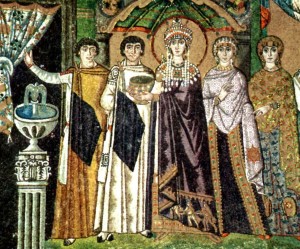Les figures féminines du pouvoir dans l’Antiquité tardive : impératrices, aristocrates, saintes et « mère de Dieu » dans les textes et l’iconographie de l’Empire romain de la fin du IVe au milieu du VIe siècle.
Pouvoirs, Institutions, Conflits
Doctorat préparé par Amélie BELLELI, sous la direction de Bertrand Lançon (Université de Limoges) et Cécile Voyer (CESCM, Poitiers).
Soutenance le 9 novembre 2019
Dans une période considérée avec inexactitude comme « charnière », entre Antiquité et Moyen Âge, on constate l’émergence d’un nombre croissant de figures féminines dans les hautes sphères du pouvoir, au sein de l’Empire Romain. Qu’elles soient impératrices, aristocrates, saintes –voire les trois en même temps –, ces femmes sont dotées de pouvoirs politiques institutionnels, sont à la tête d’un patrimoine important et disposent de grandes richesses, autant d’éléments leur conférant une réelle autonomie. Témoignant généralement d’une certaine éducation et d’une culture approfondie, ces femmes peuvent s’illustrer dans la construction d’édifices ou le financement du développement du monumental chrétien.
Avec l’avènement de la dynastie théodosienne au cours du IVe, puis Ve siècle, s’amorce un basculement. Les femmes s’installent durablement sur la scène où se joue le pouvoir. Dans le cadre de la sphère impériale, les impératrices sont de plus en plus mentionnées aux côtés de leur époux, faisant émerger une nouvelle réalité : celle du couple impérial et d’un pouvoir bicéphale.
L’hypothèse principale consiste à démontrer que, d’un point de vue historique, l’Antiquité Tardive est une période de véritable basculement dans une civilisation traditionnellement structurée mentalement par une obsession de la virilité et institutionnellement par un pouvoir politique masculin. Cette époque pourrait donc se caractériser par la naissance de la femme politique, au point que certains auteurs antiques tendent à définir la féminité au pouvoir comme une nouvelle forme de masculinité. Loin d’aller dans ce sens, ce travail amènera plutôt à se demander si un pouvoir féminin peut se dessiner sans être considéré comme une virilisation.
During a period considered with inaccuracy as « transitional », between Antiquity and the Middle Ages, we observe the appearance of an increasing number of feminine figures in the highest power spheres, in the Roman Empire. Empresses, aristocrats, saints, – all three at the same time –, these women possess institutional political powers, important patrimonial belongings and great wealth. All these elements give them a true independance. Generally reflecting a certain level of education and culture, these women can play a part in the construction of buildings or the funding of the christian architectural legacy.
With the accesssion of the theodosian dynasty during the IVth century, then the Vth, a change is initiated. Women install themselves permanently on the stage where power is decided. In the case of the imperial sphere, empresses are mentionned more often alongside their spouses, bringing forth a new reality : the imperial couple and a bicephalous power.
The main hypothesis consists in demonstrating that, from a historical point of view, Late Antiquity is a period of true evolution in a civilisation traditionally structured mentally by an obsession for manliness and institutionally by a masculine political power. This era could be caracterise by the birth of the political woman, to the point where certain authors of antiquity tend to define feminity in power as a new form of masculinity. Far from agreeing with them, this thesis will consist in asking ourselves if a feminine power can exist without being considered as a masculinization.
39E rue Camille Guérin
87036 LIMOGES Cedex
Tél. +33 (5) 05 55 43 56 00

